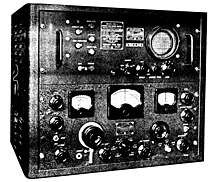The radio spectrum scope (also radio panoramic receiver, panoramic adapter, pan receiver, pan adapter, panadapter, panoramic radio spectroscope, panoramoscope, panalyzor and band scope) was invented by Marcel Wallace - and measures and shows the magnitude of an input signal versus frequency within one or more radio bands - e.g. shortwave bands.[1][2] A spectrum scope is normally a lot cheaper than a spectrum analyzer, because the aim is not high quality frequency resolution - nor high quality signal strength measurements.


The spectrum scope use can be to:
- find radio channels quickly of known and unknown signals when receiving.
- find radio amateurs activity quickly e.g. with the intent of communicating with them.
Modern spectrum scopes, like the Elecraft P3, also plot signal frequencies and amplitudes over time, in a rolling format called a waterfall plot.
References
edit- ^ Panoramic radio receiving system US 2279151 A
- ^ The History of Amateur Radio Citat: "...Panoramic reception was created in 1932 by the French engineer and ham Marcel Wallace, F3HM. The Panadaptor is the first spectrum analyzer portraying visually the signals in a selected part of the radio spectrum, making RF signals visible, identifiable my mode...", backup
External links
editWikimedia Commons has media related to Radio spectrum scopes.
- Ham radio Band-scope pan-adapter using Tek MDO4000 as a spectrum analyzer on YouTube
- K9rod.net: Spectrum Scope
- ac8gy.com: Panadapter for FT-950
- k2za.blogspot.dk: FT-817 Tip - Spectrum Scope Archived 2016-03-04 at the Wayback Machine
- portabletubes.co.uk: Panoramic Radio Products PCA-2 Panadapter
- Navy Receiving Panoramic Adaptor (Panadaptor) Info
- [1]